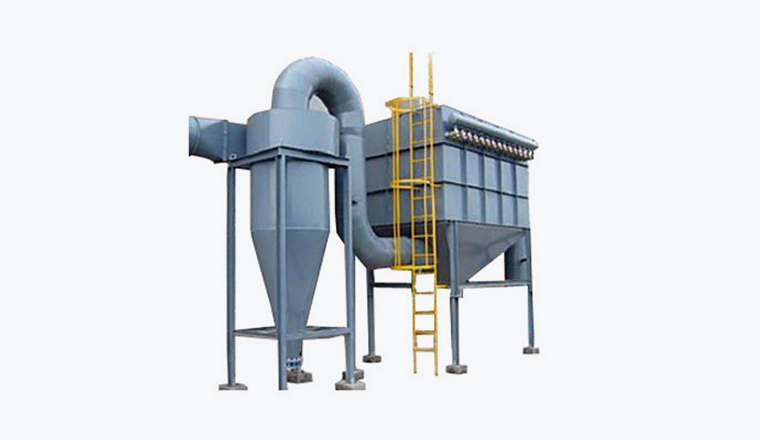Pollution Control Equipments
In Heat-Max cyclone, dusty air enters its tangential inlet, whirls through several revolutions in the body and cone, depositing its dust load, and departs, still whirling, through the axial cylindrical air-outlet, under the influence of centrifugal force, the dust particles which have been dispersed throughout the entering stream tend to concentrate in the thin layer of air next to the cyclone wall, the downward helical motion of the main air-stream and the discharge of a small quantity of air through the dust outlet tend to project the separated solids into the dust bin.
Separation Efficiency of Cyclone The centrifugal force of separation is proportional to the square of the velocity and inversely proportional to the radius of rotation. Resistance to separation is a function of the radial distance the dust particle must travel to reach the cyclone wall, its gravitational settling rate in still air, and the length of time it is acted upon by centrifugal separating forces. The time of exposure to these forces is a matter of rotational speed and the number of convolutions of the dust path from the inlet to dust outlet.
Overview
Heatmax is a focal point entity for enterprises concerned with the control of particulate and gaseous emissions. Having an extensive engagement with diverse sectors and tie-ups with technology majors has empowered the group to deliver unmatched solutions to its clientele. The group offers multifold benefits to process driven industries like cement, steel, aluminium, copper, etc., helping them recover products at various stages of plant processes and also comply with stipulated emission norms.
In an online bag filter, bags are cleaned sequentially, even when the dust laden gas is filtered. The cleaning is controlled automatically by a sequence controller. This operates the assembly of solenoid and pulse valves which direct the airflow into manifolds. The holes are jig drilled for perfect alignment with the venturi centre for achieving maximum cleaning efficiency.
The working principle of bag filter is that the dusty air flow enters the cylindrical filter bag from the lower orifice plate. When passing through the pores of the filter material, the dust is trapped on the filter material, and the clean gas passing through the filter material is discharged from the outlet. The dust deposited on the filter material can fall off from the surface of the filter material and fall into the ash hopper under the action of mechanical vibration.
Working principle:
When the flue gas passes through the bag filter, the filter material fiber screens, intercepts, inertia, diffusion, adhesion, static electricity and weight the dust is kept on the surface of the filter bag to achieve the separation of dust and gas, and to achieve the purpose of dust removal and purification of flue gas.
The working process of bag dust collector:
Flue gas into the bag dust catcher, interception, deposition of dust filter bag surface, when the dust layer after reaching a certain thickness, the resistance of the filter bag after rising, permeability decline, through the ash removal device at this time the settlement of powder layer peeling, restore the resistance of the filter bag, so the bag filter is a kind of periodic collect dust and soot cleaning work process, different types of soot cleaning bag filter structure and a different way.
Bag filter is classified by way of dust removal:
Dust removal is the decisive factor to make bag dust collector can work continuously for a long time. The basic requirement of dust removal is to quickly and evenly peel off the dust deposited on the filter bag, and usually require to maintain a certain dust layer, and do not damage the filter bag and consume less power. The characteristics of dust removal are important basis for the classification of bag filter. It can be divided into five categories: mechanical vibration type, reverse blowing type, rotary reverse blowing type, pulse blowing type and air box pulse type.



